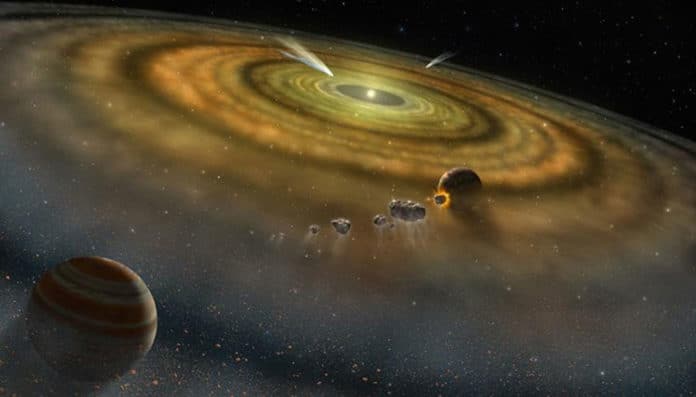The oldest solids framed in the Solar System are calcium-aluminum–rich inclusions (CAIs), small metallic droplets later incorporated into meteorites. The ages of CAIs are considered the age of the Solar System, however which exact moment in star arrangement they correspond to has been unclear.
New research by a group of Lawrence Livermore National Laboratory (LLNL) scientists- looking at isotopes of the element molybdenum found on meteorites- suggests that our sun and solar system formed over the short period of 200,000 years.
By observing other stellar systems that formed similarly to ours, astronomers gauge that it presumably takes around 1-2 million years to collapse a cloud and start a star. This is the first study that provides numbers on our solar system.
LLNL cosmochemist Greg Brennecka, lead author of a paper, said, “This work shows that this collapse, which led to the formation of the solar system, happened very quickly, in less than 200,000 years. If we scale this all to a human lifespan, the solar system’s formation would compare to pregnancy lasting about 12 hours instead of nine months. This was a rapid process.”
The micrometer-to-centimeter-sized inclusions of CAIs in a high-temperature environment (more than 1,300 Kelvin), probably near the young sun. They were then transported outward to the region where carbonaceous chondrite meteorites (and their parent bodies) formed, where they are found today. The majority of CAIs formed 4.567 billion years ago, over about 40,000 to 200,000 years.
In this study, scientists measured the molybdenum (Mo) isotopic and trace element compositions of a variety of CAIs taken from carbonaceous chondrite meteorites, including Allende, the largest carbonaceous chondrite found on Earth. Since they found that the distinct Mo isotopic compositions of CAIs cover the entire range of material framed in the protoplanetary disk rather than merely a small slice, these inclusions probably shaped within the time span of the cloud collapse.
Since the observed time span of stellar accretion (1-2 million years) is much longer than CAIs took to form, the team was able to pinpoint which the formation of CAIs recorded astronomical phase in the solar system’s formation, and ultimately, how quickly the material that makes up the solar system accreted.
Journal Reference:
- Gregory A. Brennecke et al. Astronomical context of Solar System formation from molybdenum isotopes in meteorite inclusions, Science (2020). DOI: 10.1126/science.aaz8482
